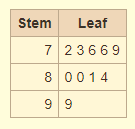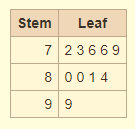
Pre-Algebra, Student Edition
1st Edition
ISBN: 9780078885150
Author: McGraw-Hill
Publisher: Glencoe/McGraw-Hill
expand_more
expand_more
format_list_bulleted
Question
Chapter 13.2, Problem 1CYU
To determine
The stem and leaf plot of the given set of data
Expert Solution & Answer
Answer to Problem 1CYU

Explanation of Solution
Given:
The given data is

Calculation:
The stem and leaf plot can be drawn as

Chapter 13 Solutions
Pre-Algebra, Student Edition
Ch. 13.1 - Prob. 1CYPCh. 13.1 - Prob. 2CYPCh. 13.1 - Prob. 3CYPCh. 13.1 - Prob. 4CYPCh. 13.1 - Prob. 1CYUCh. 13.1 - Prob. 2CYUCh. 13.1 - Prob. 3CYUCh. 13.1 - Prob. 4CYUCh. 13.1 - Prob. 5CYUCh. 13.1 - Prob. 6PPS
Ch. 13.1 - Prob. 7PPSCh. 13.1 - Prob. 8PPSCh. 13.1 - Prob. 9PPSCh. 13.1 - Prob. 10PPSCh. 13.1 - Prob. 11PPSCh. 13.1 - Prob. 12PPSCh. 13.1 - Prob. 13PPSCh. 13.1 - Prob. 14PPSCh. 13.1 - Prob. 15PPSCh. 13.1 - Prob. 16HPCh. 13.1 - Prob. 17HPCh. 13.1 - Prob. 18HPCh. 13.1 - Prob. 19HPCh. 13.1 - Prob. 20HPCh. 13.1 - Prob. 21HPCh. 13.1 - Prob. 22STPCh. 13.1 - Prob. 23STPCh. 13.1 - Prob. 24STPCh. 13.1 - Prob. 25STPCh. 13.1 - Prob. 26SRCh. 13.1 - Prob. 27SRCh. 13.1 - Prob. 28SRCh. 13.1 - Prob. 29SCh. 13.2 - Prob. 1CYPCh. 13.2 - Prob. 2ACYPCh. 13.2 - Prob. 2BCYPCh. 13.2 - Prob. 3ACYPCh. 13.2 - Prob. 3BCYPCh. 13.2 - Prob. 1CYUCh. 13.2 - Prob. 2CYUCh. 13.2 - Prob. 3CYUCh. 13.2 - Prob. 4CYUCh. 13.2 - Prob. 5PPSCh. 13.2 - Prob. 6PPSCh. 13.2 - Prob. 7PPSCh. 13.2 - Prob. 8PPSCh. 13.2 - Prob. 9PPSCh. 13.2 - Prob. 10PPSCh. 13.2 - Prob. 11PPSCh. 13.2 - Prob. 12PPSCh. 13.2 - Prob. 13PPSCh. 13.2 - Prob. 14PPSCh. 13.2 - Prob. 15PPSCh. 13.2 - Prob. 16PPSCh. 13.2 - Prob. 17HPCh. 13.2 - Prob. 18HPCh. 13.2 - Prob. 19HPCh. 13.2 - Prob. 20HPCh. 13.2 - Prob. 21HPCh. 13.2 - Prob. 22STPCh. 13.2 - Prob. 23STPCh. 13.2 - Prob. 24STPCh. 13.2 - Prob. 25STPCh. 13.2 - Prob. 26SRCh. 13.2 - Prob. 27SRCh. 13.2 - Prob. 28SRCh. 13.2 - Prob. 29SRCh. 13.2 - Prob. 30SCh. 13.2 - Prob. 31SCh. 13.2 - Prob. 32SCh. 13.2 - Prob. 33SCh. 13.3 - Prob. 1ACYPCh. 13.3 - Prob. 1BCYPCh. 13.3 - Prob. 2CYPCh. 13.3 - Prob. 3CYPCh. 13.3 - Prob. 4CYPCh. 13.3 - Prob. 5CYPCh. 13.3 - Prob. 1CYUCh. 13.3 - Prob. 2CYUCh. 13.3 - Prob. 3CYUCh. 13.3 - Prob. 4PPSCh. 13.3 - Prob. 5PPSCh. 13.3 - Prob. 6PPSCh. 13.3 - Prob. 7PPSCh. 13.3 - Prob. 8PPSCh. 13.3 - Prob. 9PPSCh. 13.3 - Prob. 10PPSCh. 13.3 - Prob. 11PPSCh. 13.3 - Prob. 12HPCh. 13.3 - Prob. 13HPCh. 13.3 - Prob. 14HPCh. 13.3 - Prob. 15HPCh. 13.3 - Prob. 16HPCh. 13.3 - Prob. 17STPCh. 13.3 - Prob. 18STPCh. 13.3 - Prob. 19STPCh. 13.3 - Prob. 20STPCh. 13.3 - Prob. 21SRCh. 13.3 - Prob. 22SRCh. 13.3 - Prob. 23SRCh. 13.3 - Prob. 24SRCh. 13.3 - Prob. 25SRCh. 13.3 - Prob. 26SRCh. 13.3 - Prob. 27SRCh. 13.3 - Prob. 28SCh. 13.3 - Prob. 29SCh. 13.4 - Prob. 1CYPCh. 13.4 - Prob. 2CYPCh. 13.4 - Prob. 3CYPCh. 13.4 - Prob. 1CYUCh. 13.4 - Prob. 2CYUCh. 13.4 - Prob. 3CYUCh. 13.4 - Prob. 4PPSCh. 13.4 - Prob. 5PPSCh. 13.4 - Prob. 6PPSCh. 13.4 - Prob. 7PPSCh. 13.4 - Prob. 8PPSCh. 13.4 - Prob. 9PPSCh. 13.4 - Prob. 10PPSCh. 13.4 - Prob. 11PPSCh. 13.4 - Prob. 12PPSCh. 13.4 - Prob. 13HPCh. 13.4 - Prob. 14HPCh. 13.4 - Prob. 15HPCh. 13.4 - Prob. 16HPCh. 13.4 - Prob. 17STPCh. 13.4 - Prob. 18STPCh. 13.4 - Prob. 19STPCh. 13.4 - Prob. 20STPCh. 13.4 - Prob. 21SRCh. 13.4 - Prob. 22SCh. 13.5 - Prob. 1CYPCh. 13.5 - Prob. 2CYPCh. 13.5 - Prob. 1CYUCh. 13.5 - Prob. 2CYUCh. 13.5 - Prob. 3CYUCh. 13.5 - Prob. 4CYUCh. 13.5 - Prob. 5PPSCh. 13.5 - Prob. 6PPSCh. 13.5 - Prob. 7PPSCh. 13.5 - Prob. 8PPSCh. 13.5 - Prob. 9PPSCh. 13.5 - Prob. 10PPSCh. 13.5 - Prob. 11PPSCh. 13.5 - Prob. 12HPCh. 13.5 - Prob. 13HPCh. 13.5 - Prob. 14HPCh. 13.5 - Prob. 15HPCh. 13.5 - Prob. 16HPCh. 13.5 - Prob. 17STPCh. 13.5 - Prob. 18STPCh. 13.5 - Prob. 19STPCh. 13.5 - Prob. 20STPCh. 13.5 - Prob. 21SRCh. 13.5 - Prob. 22SRCh. 13.5 - Prob. 23SCh. 13.5 - Prob. 24SCh. 13.5 - Prob. 25SCh. 13.6 - Prob. 1CYPCh. 13.6 - Prob. 2CYPCh. 13.6 - Prob. 3CYPCh. 13.6 - Prob. 4CYPCh. 13.6 - Prob. 5CYPCh. 13.6 - Prob. 1CYUCh. 13.6 - Prob. 2CYUCh. 13.6 - Prob. 3CYUCh. 13.6 - Prob. 4CYUCh. 13.6 - Prob. 5CYUCh. 13.6 - Prob. 6CYUCh. 13.6 - Prob. 7CYUCh. 13.6 - Prob. 8CYUCh. 13.6 - Prob. 9PPSCh. 13.6 - Prob. 10PPSCh. 13.6 - Prob. 11PPSCh. 13.6 - Prob. 12PPSCh. 13.6 - Prob. 13PPSCh. 13.6 - Prob. 14PPSCh. 13.6 - Prob. 15PPSCh. 13.6 - Prob. 16PPSCh. 13.6 - Prob. 17PPSCh. 13.6 - Prob. 18PPSCh. 13.6 - Prob. 19PPSCh. 13.6 - Prob. 20PPSCh. 13.6 - Prob. 21PPSCh. 13.6 - Prob. 22HPCh. 13.6 - Prob. 23HPCh. 13.6 - Prob. 24HPCh. 13.6 - Prob. 25HPCh. 13.6 - Prob. 26STPCh. 13.6 - Prob. 27STPCh. 13.6 - Prob. 28STPCh. 13.6 - Prob. 29STPCh. 13.6 - Prob. 30SRCh. 13.6 - Prob. 31SRCh. 13.6 - Prob. 32SCh. 13.6 - Prob. 33SCh. 13.6 - Prob. 34SCh. 13.6 - Prob. 35SCh. 13.7 - Prob. 1CYPCh. 13.7 - Prob. 2CYPCh. 13.7 - Prob. 3CYPCh. 13.7 - Prob. 1CYUCh. 13.7 - Prob. 2CYUCh. 13.7 - Prob. 3CYUCh. 13.7 - Prob. 4CYUCh. 13.7 - Prob. 5PPSCh. 13.7 - Prob. 6PPSCh. 13.7 - Prob. 7PPSCh. 13.7 - Prob. 8PPSCh. 13.7 - Prob. 9PPSCh. 13.7 - Prob. 10PPSCh. 13.7 - Prob. 11PPSCh. 13.7 - Prob. 12PPSCh. 13.7 - Prob. 13PPSCh. 13.7 - Prob. 14PPSCh. 13.7 - Prob. 15PPSCh. 13.7 - Prob. 16PPSCh. 13.7 - Prob. 17HPCh. 13.7 - Prob. 18HPCh. 13.7 - Prob. 19HPCh. 13.7 - Prob. 20HPCh. 13.7 - Prob. 21STPCh. 13.7 - Prob. 22STPCh. 13.7 - Prob. 23STPCh. 13.7 - Prob. 24STPCh. 13.7 - Prob. 25SRCh. 13.7 - Prob. 26SRCh. 13.7 - Prob. 27SRCh. 13.7 - Prob. 28SRCh. 13.7 - Prob. 29SRCh. 13.7 - Prob. 30SRCh. 13.7 - Prob. 31SCh. 13.7 - Prob. 32SCh. 13.7 - Prob. 33SCh. 13.7 - Prob. 34SCh. 13.8 - Prob. 1CYPCh. 13.8 - Prob. 2CYPCh. 13.8 - Prob. 3CYPCh. 13.8 - Prob. 4CYPCh. 13.8 - Prob. 1CYUCh. 13.8 - Prob. 2CYUCh. 13.8 - Prob. 3CYUCh. 13.8 - Prob. 4CYUCh. 13.8 - Prob. 5CYUCh. 13.8 - Prob. 6PPSCh. 13.8 - Prob. 7PPSCh. 13.8 - Prob. 8PPSCh. 13.8 - Prob. 9PPSCh. 13.8 - Prob. 10PPSCh. 13.8 - Prob. 11PPSCh. 13.8 - Prob. 12PPSCh. 13.8 - Prob. 13PPSCh. 13.8 - Prob. 14PPSCh. 13.8 - Prob. 15PPSCh. 13.8 - Prob. 16HPCh. 13.8 - Prob. 17HPCh. 13.8 - Prob. 18HPCh. 13.8 - Prob. 19HPCh. 13.8 - Prob. 20HPCh. 13.8 - Prob. 21STPCh. 13.8 - Prob. 22STPCh. 13.8 - Prob. 23STPCh. 13.8 - Prob. 24STPCh. 13.8 - Prob. 25SRCh. 13.8 - Prob. 26SRCh. 13.8 - Prob. 27SRCh. 13.8 - Prob. 28SRCh. 13.8 - Prob. 29SCh. 13.8 - Prob. 30SCh. 13.8 - Prob. 31SCh. 13.8 - Prob. 32SCh. 13.9 - Prob. 1ACYPCh. 13.9 - Prob. 1BCYPCh. 13.9 - Prob. 2CYPCh. 13.9 - Prob. 3ACYPCh. 13.9 - Prob. 3BCYPCh. 13.9 - Prob. 4CYPCh. 13.9 - Prob. 1CYUCh. 13.9 - Prob. 2CYUCh. 13.9 - Prob. 3CYUCh. 13.9 - Prob. 4CYUCh. 13.9 - Prob. 5PPSCh. 13.9 - Prob. 6PPSCh. 13.9 - Prob. 7PPSCh. 13.9 - Prob. 8PPSCh. 13.9 - Prob. 9PPSCh. 13.9 - Prob. 10PPSCh. 13.9 - Prob. 11PPSCh. 13.9 - Prob. 12PPSCh. 13.9 - Prob. 13PPSCh. 13.9 - Prob. 14PPSCh. 13.9 - Prob. 15PPSCh. 13.9 - Prob. 16PPSCh. 13.9 - Prob. 17PPSCh. 13.9 - Prob. 18PPSCh. 13.9 - Prob. 19PPSCh. 13.9 - Prob. 20PPSCh. 13.9 - Prob. 21PPSCh. 13.9 - Prob. 22PPSCh. 13.9 - Prob. 23PPSCh. 13.9 - Prob. 24PPSCh. 13.9 - Prob. 25PPSCh. 13.9 - Prob. 26PPSCh. 13.9 - Prob. 27PPSCh. 13.9 - Prob. 28PPSCh. 13.9 - Prob. 29PPSCh. 13.9 - Prob. 30PPSCh. 13.9 - Prob. 31PPSCh. 13.9 - Prob. 32PPSCh. 13.9 - Prob. 33HPCh. 13.9 - Prob. 34HPCh. 13.9 - Prob. 35HPCh. 13.9 - Prob. 36HPCh. 13.9 - Prob. 37HPCh. 13.9 - Prob. 38STPCh. 13.9 - Prob. 39STPCh. 13.9 - Prob. 40STPCh. 13.9 - Prob. 41STPCh. 13.9 - Prob. 42SRCh. 13.9 - Prob. 43SRCh. 13.9 - Prob. 44SRCh. 13.9 - Prob. 45SRCh. 13.9 - Prob. 46SRCh. 13.9 - Prob. 47SRCh. 13.9 - Prob. 48SRCh. 13.9 - Prob. 49SCh. 13.9 - Prob. 50SCh. 13.9 - Prob. 51SCh. 13.9 - Prob. 52SCh. 13.10 - Prob. 1ACYPCh. 13.10 - Prob. 1BCYPCh. 13.10 - Prob. 2ACYPCh. 13.10 - Prob. 2BCYPCh. 13.10 - Prob. 3CYPCh. 13.10 - Prob. 1CYUCh. 13.10 - Prob. 2CYUCh. 13.10 - Prob. 3CYUCh. 13.10 - Prob. 4CYUCh. 13.10 - Prob. 5PPSCh. 13.10 - Prob. 6PPSCh. 13.10 - Prob. 7PPSCh. 13.10 - Prob. 8PPSCh. 13.10 - Prob. 9PPSCh. 13.10 - Prob. 10PPSCh. 13.10 - Prob. 11PPSCh. 13.10 - Prob. 12PPSCh. 13.10 - Prob. 13PPSCh. 13.10 - Prob. 14PPSCh. 13.10 - Prob. 15PPSCh. 13.10 - Prob. 16PPSCh. 13.10 - Prob. 17PPSCh. 13.10 - Prob. 18PPSCh. 13.10 - Prob. 19PPSCh. 13.10 - Prob. 20PPSCh. 13.10 - Prob. 21PPSCh. 13.10 - Prob. 22PPSCh. 13.10 - Prob. 23PPSCh. 13.10 - Prob. 24PPSCh. 13.10 - Prob. 25PPSCh. 13.10 - Prob. 26HPCh. 13.10 - Prob. 27HPCh. 13.10 - Prob. 28HPCh. 13.10 - Prob. 29HPCh. 13.10 - Prob. 30HPCh. 13.10 - Prob. 31STPCh. 13.10 - Prob. 32STPCh. 13.10 - Prob. 33STPCh. 13.10 - Prob. 34STPCh. 13.10 - Prob. 35SRCh. 13.10 - Prob. 36SRCh. 13.10 - Prob. 37SRCh. 13.10 - Prob. 38SRCh. 13.10 - Prob. 39SRCh. 13.10 - Prob. 40SRCh. 13 - Prob. 1QCCh. 13 - Prob. 2QCCh. 13 - Prob. 3QCCh. 13 - Prob. 4QCCh. 13 - Prob. 5QCCh. 13 - Prob. 6QCCh. 13 - Prob. 7QCCh. 13 - Prob. 8QCCh. 13 - Prob. 9QCCh. 13 - Prob. 10QCCh. 13 - Prob. 11QCCh. 13 - Prob. 12QCCh. 13 - Prob. 13QCCh. 13 - Prob. 1MCQCh. 13 - Prob. 2MCQCh. 13 - Prob. 3MCQCh. 13 - Prob. 4MCQCh. 13 - Prob. 5MCQCh. 13 - Prob. 6MCQCh. 13 - Prob. 7MCQCh. 13 - Prob. 8MCQCh. 13 - Prob. 9MCQCh. 13 - Prob. 10MCQCh. 13 - Prob. 11MCQCh. 13 - Prob. 12MCQCh. 13 - Prob. 1SGRCh. 13 - Prob. 2SGRCh. 13 - Prob. 3SGRCh. 13 - Prob. 4SGRCh. 13 - Prob. 5SGRCh. 13 - Prob. 6SGRCh. 13 - Prob. 7SGRCh. 13 - Prob. 8SGRCh. 13 - Prob. 9SGRCh. 13 - Prob. 10SGRCh. 13 - Prob. 11SGRCh. 13 - Prob. 12SGRCh. 13 - Prob. 13SGRCh. 13 - Prob. 14SGRCh. 13 - Prob. 15SGRCh. 13 - Prob. 16SGRCh. 13 - Prob. 17SGRCh. 13 - Prob. 18SGRCh. 13 - Prob. 19SGRCh. 13 - Prob. 20SGRCh. 13 - Prob. 21SGRCh. 13 - Prob. 22SGRCh. 13 - Prob. 23SGRCh. 13 - Prob. 24SGRCh. 13 - Prob. 25SGRCh. 13 - Prob. 26SGRCh. 13 - Prob. 27SGRCh. 13 - Prob. 28SGRCh. 13 - Prob. 29SGRCh. 13 - Prob. 30SGRCh. 13 - Prob. 31SGRCh. 13 - Prob. 32SGRCh. 13 - Prob. 33SGRCh. 13 - Prob. 34SGRCh. 13 - Prob. 35SGRCh. 13 - Prob. 36SGRCh. 13 - Prob. 37SGRCh. 13 - Prob. 38SGRCh. 13 - Prob. 39SGRCh. 13 - Prob. 40SGRCh. 13 - Prob. 41SGRCh. 13 - Prob. 42SGRCh. 13 - Prob. 1PTCh. 13 - Prob. 2PTCh. 13 - Prob. 3PTCh. 13 - Prob. 4PTCh. 13 - Prob. 5PTCh. 13 - Prob. 6PTCh. 13 - Prob. 7PTCh. 13 - Prob. 8PTCh. 13 - Prob. 9PTCh. 13 - Prob. 10PTCh. 13 - Prob. 11PTCh. 13 - Prob. 12PTCh. 13 - Prob. 13PTCh. 13 - Prob. 14PTCh. 13 - Prob. 15PTCh. 13 - Prob. 16PTCh. 13 - Prob. 17PTCh. 13 - Prob. 18PTCh. 13 - Prob. 19PTCh. 13 - Prob. 20PTCh. 13 - Prob. 1ECh. 13 - Prob. 2ECh. 13 - Prob. 1STPCh. 13 - Prob. 2STPCh. 13 - Prob. 3STPCh. 13 - Prob. 4STPCh. 13 - Prob. 5STPCh. 13 - Prob. 6STPCh. 13 - Prob. 7STPCh. 13 - Prob. 8STPCh. 13 - Prob. 9STPCh. 13 - Prob. 10STPCh. 13 - Prob. 11STPCh. 13 - Prob. 12STPCh. 13 - Prob. 13STP
Additional Math Textbook Solutions
Find more solutions based on key concepts
Violins Professional musicians listened to five violins being played, without seeing the instruments. One violi...
Introductory Statistics
Linear independence A pair of nonzero vectors in the plane is linearly dependent if one vector is a scalar mult...
Calculus: Early Transcendentals (2nd Edition)
4. Correlation and Causation What is meant by the statement that “correlation does imply causation”?
Elementary Statistics
Limits of sequences Find the limit of the following sequences or determine that the limit does not exist. 11. {...
Calculus: Early Transcendentals (2nd Edition)
Explain why commands and questions are not statements.
A Problem Solving Approach To Mathematics For Elementary School Teachers (13th Edition)
Knowledge Booster
Learn more about
Need a deep-dive on the concept behind this application? Look no further. Learn more about this topic, algebra and related others by exploring similar questions and additional content below.Similar questions
- Safari File Edit View History Bookmarks Window Help Ο Ω OV O mA 0 mW ర Fri Apr 4 1 222 tv A F9 F10 DII 4 F6 F7 F8 7 29 8 00 W E R T Y U S D பட 9 O G H J K E F11 + 11 F12 O P } [arrow_forwardSo confused. Step by step instructions pleasearrow_forwardIn simplest terms, Sketch the graph of the parabola. Then, determine its equation. opens downward, vertex is (- 4, 7), passes through point (0, - 39)arrow_forward
- In simplest way, For each quadratic relation, find the zeros and the maximum or minimum. a) y = x 2 + 16 x + 39 b) y = 5 x2 - 50 x - 120arrow_forwardIn simplest terms and step by step Write each quadratic relation in standard form, then fi nd the zeros. y = - 4( x + 6)2 + 36arrow_forwardIn simplest terms and step by step For each quadratic relation, find the zeros and the maximum or minimum. 1) y = - 2 x2 - 28 x + 64 2) y = 6 x2 + 36 x - 42arrow_forward
- Write each relation in standard form a)y = 5(x + 10)2 + 7 b)y = 9(x - 8)2 - 4arrow_forwardIn simplest form and step by step Write the quadratic relation in standard form, then fi nd the zeros. y = 3(x - 1)2 - 147arrow_forwardStep by step instructions The path of a soccer ball can be modelled by the relation h = - 0.1 d 2 + 0.5 d + 0.6, where h is the ball’s height and d is the horizontal distance from the kicker. a) Find the zeros of the relation.arrow_forward
arrow_back_ios
SEE MORE QUESTIONS
arrow_forward_ios
Recommended textbooks for you
 Algebra and Trigonometry (6th Edition)AlgebraISBN:9780134463216Author:Robert F. BlitzerPublisher:PEARSON
Algebra and Trigonometry (6th Edition)AlgebraISBN:9780134463216Author:Robert F. BlitzerPublisher:PEARSON Contemporary Abstract AlgebraAlgebraISBN:9781305657960Author:Joseph GallianPublisher:Cengage Learning
Contemporary Abstract AlgebraAlgebraISBN:9781305657960Author:Joseph GallianPublisher:Cengage Learning Linear Algebra: A Modern IntroductionAlgebraISBN:9781285463247Author:David PoolePublisher:Cengage Learning
Linear Algebra: A Modern IntroductionAlgebraISBN:9781285463247Author:David PoolePublisher:Cengage Learning Algebra And Trigonometry (11th Edition)AlgebraISBN:9780135163078Author:Michael SullivanPublisher:PEARSON
Algebra And Trigonometry (11th Edition)AlgebraISBN:9780135163078Author:Michael SullivanPublisher:PEARSON Introduction to Linear Algebra, Fifth EditionAlgebraISBN:9780980232776Author:Gilbert StrangPublisher:Wellesley-Cambridge Press
Introduction to Linear Algebra, Fifth EditionAlgebraISBN:9780980232776Author:Gilbert StrangPublisher:Wellesley-Cambridge Press College Algebra (Collegiate Math)AlgebraISBN:9780077836344Author:Julie Miller, Donna GerkenPublisher:McGraw-Hill Education
College Algebra (Collegiate Math)AlgebraISBN:9780077836344Author:Julie Miller, Donna GerkenPublisher:McGraw-Hill Education

Algebra and Trigonometry (6th Edition)
Algebra
ISBN:9780134463216
Author:Robert F. Blitzer
Publisher:PEARSON

Contemporary Abstract Algebra
Algebra
ISBN:9781305657960
Author:Joseph Gallian
Publisher:Cengage Learning

Linear Algebra: A Modern Introduction
Algebra
ISBN:9781285463247
Author:David Poole
Publisher:Cengage Learning

Algebra And Trigonometry (11th Edition)
Algebra
ISBN:9780135163078
Author:Michael Sullivan
Publisher:PEARSON

Introduction to Linear Algebra, Fifth Edition
Algebra
ISBN:9780980232776
Author:Gilbert Strang
Publisher:Wellesley-Cambridge Press

College Algebra (Collegiate Math)
Algebra
ISBN:9780077836344
Author:Julie Miller, Donna Gerken
Publisher:McGraw-Hill Education
How to make Frequency Distribution Table / Tally Marks and Frequency Distribution Table; Author: Reenu Math;https://www.youtube.com/watch?v=i_A6RiE8tLE;License: Standard YouTube License, CC-BY
Frequency distribution table in statistics; Author: Math and Science;https://www.youtube.com/watch?v=T7KYO76DoOE;License: Standard YouTube License, CC-BY
Frequency Distribution Table for Grouped/Continuous data | Math Dot Com; Author: Maths dotcom;https://www.youtube.com/watch?v=ErnccbXQOPY;License: Standard Youtube License